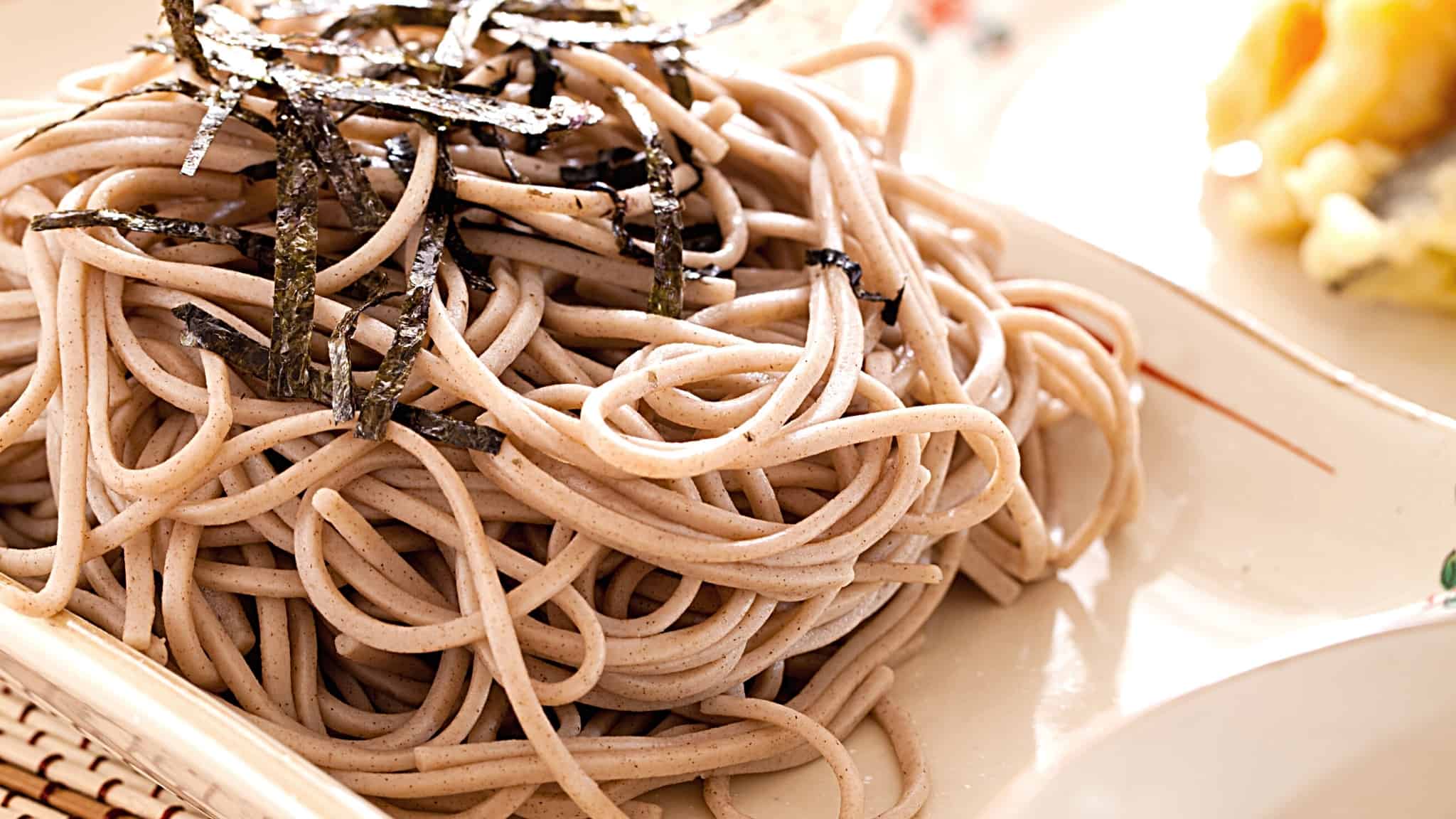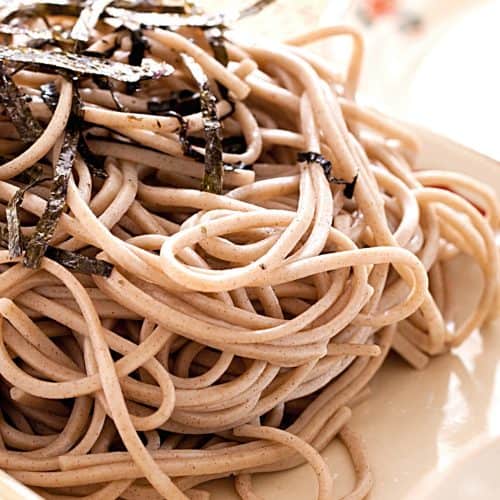Zaru soba recipe | Simple but exciting dish for a refreshing experience
Zaru soba is a light and refreshing meal that’s great on a summer day.
Also known as classic cold noodles, zaru soba is a light, hot weather food that is perfect for cooling down.
It’s made from buckwheat flour with a soy sauce-based dipping sauce called tsuyu served on the side. It takes is easy to make so you don’t have to spend a lot of time in a hot kitchen.

This article will give you the down-low on how you can cook up a batch of zaru soba in your kitchen.


Check out our new cookbook
Bitemybun's family recipes with complete meal planner and recipe guide.
Try it out for free with Kindle Unlimited:
Read for freeIn this post we'll cover:
Zaru soba recipe
Ingredients
- 14 oz. dried soba noodles
- 1 part ice water
- 1 part mentsuyu/tsuyu noodle soup base
- shredded nori seaweed
- 2 green onions or scallions
- wasabi optional
You can buy mentsuyu in a store, but if you prefer to make your own, here are the ingredients you will need:
- ½ cup mirin
- ¼ cup sake
- ½ cup soy sauce
- 1 cup katsuobushi bonito flakes
- 1 1 inch x 1 inch piece kombu
Instructions
Dipping sauce
- Make mentsuyu dipping sauce by adding the sake to a medium saucepan and boil over medium heat. Let boil for a few seconds to allow alcohol to evaporate.
- Add soy sauce and mirin.
- Add kombu and katsuobushi.
- Bring to a boil and cook over low heat for five minutes. Allow to cool completely. Strain sauce and set aside.
Soba noodles
- Boil water in a large pot and add soba noodles. Do not add salt to water. Cook according to package directions stirring regularly to ensure they don’t stick together. Before draining, reserve one to 1 ½ cups water and set aside.
- Drain noodles and rinse with cold water.
- Transfer noodles to a large bowl of ice water so they cool completely.
- Place a bamboo mat or sieve over a plate to serve. The plate will catch the water from the noodles. Put soba noodles on the mat and garnish with nori.
- To serve the dish, combine 6 tbsp. water with about 1 ¼ cup dipping sauce. (This will get you the 3:1 ratio). If it’s too salty, add more water. If it’s too thin, add more sauce.
- Put chopped green onions and wasabi on a small plate and serve with the noodles.
Video
How to make vegan / gluten-free zaru soba
To make this zaru soba recipe vegan-friendly and suitable for a gluten-freediet, simply replace a few of the ingredients.
Most importantly, you want to use an animal-product-free mentsuyu. You can buy a vegetarian one, or when you are making the dipping sauce from scratch, be sure to leave out the bonito flakes.
You can replace these with dried mushrooms, like shiitake, to still get the deep umami flavor you want for this sauce.
To make it gluten-free, be sure to use 100% buckwheat soba noodles, and pick a gluten-free soy sauce or go for tamari.
For the perfect vegan accompaniment for zaru soba, check out this Teriyaki tofu recipe!
How do you eat soba noodles?
Soba noodles are served in a very specific way.
Each guest is served the noodles on an individual plate, with a bamboo mat under it, to drain the water.
The dipping sauce is combined with ice water in a 3:1 ratio with 3 parts water and 1 part dipping sauce served in a pitcher.
The pitcher is placed on the table along with small dishes that contain condiments like wasabi, scallions, shredded nori and any other you prefer. Add condiments to noodles if desired.
Then, use your utensil to pick up the noodles and dip them in the sauce. Slurp the noodles. (Note, slurping is not considered rude in Japanese culture).
It’s important not to leave the noodles in the sauce for too long or they will get salty.
When you’re done with the noodles, you can pour the remainder of the dipping sauce mixture into the rest of your dipping sauce and eat it as a soup.
What can you serve with zaru soba?
You can eat zaru soba on its own but if you’d rather have a more filling meal, here are some things you can add
- Shrimp or Vegetable Tempura: Japanese-style fried shrimp or vegetables will taste delicious over cold noodles.
- Quail Eggs: In order to eat quail eggs with zaru soba, you will want to place the egg (with the top peeled off) onto a separate plate with radish and onion. Dip these into the mentsuyu. Then take soba and put into onto the plate. Swirl the ingredients together and eat.
- Tofu and Eggplant: Tofu, eggplant, and soba make a light, healthy summer dish.
- Salmon: Salmon is delicious over soba. Serve it teriyaki style, miso-glazed, or slightly crispy.
- Yamaimo: Yamaimo is a Japanese mountain yam that can be served hot or cold grated over soba.
- Other vegetables or meats: Almost any vegetable or meat will taste good on top of soba. Just keep in mind that adding hot food will make the noodles hot. If you are set on enjoying a cold dish, stay away from foods that will not taste good unless they are heated.
- Egg: Get an extra dose of protein by eating soba with a raw egg cracked over it.
About that raw egg: Why do the Japanese put Raw Egg on Rice? Is it safe?
What is the origin of zaru soba?
Zaru soba originates in Japan’s Edo period. The word zaru means strainer in Japanese and soba is the word for buckwheat noodles.
The dish is a takeoff on how noodles were served over a bamboo strainer way back when.
What are the types of soba?
There are different kinds of soba and they vary in their ratio of buckwheat flour which affects the texture and flavor of the dish.
The different types include:
- Ju-wari soba: This type of soba is made from 100% buckwheat flour. Its dry, rough texture means the noodles break easily so they are difficult to use when cooking.
- Hachi-wari soba: This type of soba is made from 80% buckwheat flour and 20% wheat flour. It is smoother and easier to use in cooking. It is also easier to chew and swallow. However, it lacks the strong buckwheat aroma that Ju-wari soba has and is, therefore, not as flavorful.
What are the different flavors of buckwheat soba noodles?
The noodles can be further categorized by their flavoring. You may see green and pink noodles in the store.
Here’s what you can expect from each:
- Green tea soba: These noodles are flavored with a small amount of green tea powder that gives them a unique flavor and a green color.
- Ume plum soba: These noodles are flavored with Japanese ume plum and have a pink coloring.
Now that you know more about zaru soba, how will you be preparing it when the warm weather rolls around?
Soba noodles are not the same as udon noodles! What Are The Thick Japanese Noodles Called?
Check out our new cookbook
Bitemybun's family recipes with complete meal planner and recipe guide.
Try it out for free with Kindle Unlimited:
Read for freeJoost Nusselder, the founder of Bite My Bun is a content marketer, dad and loves trying out new food with Japanese food at the heart of his passion, and together with his team he's been creating in-depth blog articles since 2016 to help loyal readers with recipes and cooking tips.
